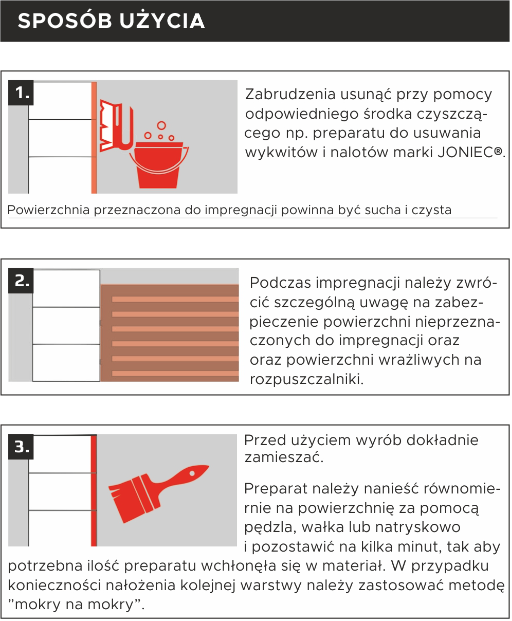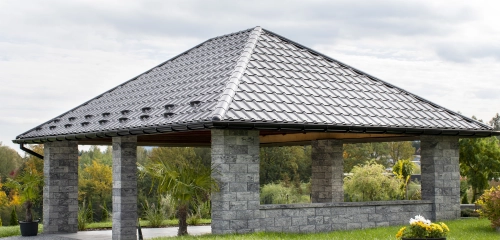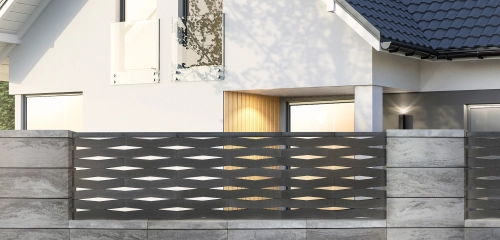A concrete fence is not only the protection of our property, but above all its showpiece. For this reason, it is worth cleaning and impregnating it regularly. Repeating this process will ensure that the aesthetic qualities of the fence will not change even after several years of use. When cleaning and impregnating, care should be taken to choose the right chemicals and follow the manufacturer's recommendations.
What should you clean your concrete fence with?
The cyclic cleaning of a concrete fence from dirt such as mud, dust and fresh deposits can be done with a pressure washer. Thoroughly rinsing the entire fence surface with pressurised water, should remove most of the superficial dirt. This process will be even more effective if the fence has been previously impregnated.Occasionally, efflorescence and organic dirt will appear on the surface of the fence blocks. If this occurs, it may be necessary to purchase a suitable product. It will effectively help to combat efflorescence and dirt, saving time and restoring the fence to its original visual state.
-3.jpg)
Ogrodzenie ROMA Mega w kolorze Gabro
What stain and efflorescence remover should you use?
The choice of stain and efflorescence remover depends on the type of stain and efflorescence.The most common are lime (carbonate) efflorescence. Their formation is a natural process that manifests itself on concrete fences, usually after the completion of construction. The phenomenon is temporary and, depending on its intensity, gradually disappears. On the fence, it manifests itself in the form of a white coating or streaking.
To remove lime efflorescence, a strong acid-based agent is ideal. JONIEC® efflorescence and stain remover, specially developed for concrete fences, is ideal here. It can be used to remove the defects described above and also to clean the surface prior to impregnation. It is also effective against cement stains and lime efflorescence on paving stones, clinker bricks and concrete blocks.
Another occasionally occurring case is the appearance of organic dirt on the fence, such as grease, oil, mosses and fungi. The latter are most likely to occur in shaded and damp areas and in contact with plants.
Organic dirt can be effectively removed with strong alkaline products.
How to remove lime efflorescence?
When trying to get rid of unwanted tarnish, it is a good idea to start by flushing the fence with pressurised water. This should remove some of the dirt and tarnish produced during and after construction.If visible efflorescence and dirt still remain on the fence after rinsing, use an efflorescence and tarnish remover.
Apply efflorescent and tarnish remover evenly with a brush or spray only in the areas where efflorescence occurs. Rinse with a jet of water after waiting 2-3 minutes. It is important not to allow the product to dry on the surface to be cleaned.
In the case of difficult stains, the product should be applied again and mechanically rubbed into the surface. A rough brush can be used for this. Rinse the fence thoroughly with water afterwards.
Before carrying out the actual cleaning of the fence with the product, it is recommended to carry out a trial application of the product in the least visible part of the fence. This is to determine possible undesirable effects, e.g. damage or discolouration of the surface to be cleaned.
Which impregnate should I choose?
(Based on the example of JONIEC® impregnates)
There are many types of impregnates available on the market. It is important to remember that NOT EVERY one will be suitable for a given fence. They differ in their mode of action and visual effect. Their application for impregnation is mainly influenced by the colour and texture of the block.We can divide impregnating agents into two groups:
- Water-based impregnants - are the most versatile.
JONIEC® offers two water-based agents:
Universal water-repellent impregnator - It can be used for all types of blocks offered by JONIEC®. It does not change their colour or strengthen them. It is most often used for fences where SCRATCH technology is used (the result of its application is a unique, gently ribbed texture of the block surface). These include: ROMA Perfect, ROMA Diamond, ROMA Nova and GORC® Top.
Effects of action:
- forms a protective membrane protecting the surface of the fence against water penetration- the hydrophobic layer created significantly reduces the surface absorption of water
- Binds dust and prevents surface contamination
- The surface does not change its original colour
- prolongs the life span of the fence
- The surface retains its breathability
- Increases frost resistance parameters MASTER waterproofing - will work for most types of fences, excluding light colours: GORC® de Luxe in SILVER, ROMA Horizon in white, ROMA Mega in SNOW. The agent produces a "wet stone" effect on the surface, which enhances the colour and increases the aesthetic value of the fence.
Other effects are similar to those of the hydrophobic impregnate.
Colour impregnates (white and graphite) - this product is dedicated to ROMA Horizon fences in Graphite and White. It has colouring properties, so it permanently colours the painted surfaces, refreshing and revitalising their appearance.
Effects of action:
- has the ability to penetrate deep into the substrate, protecting it from the damaging effects of water and frost- increases the lifespan of the fence and concrete substrate
- refreshes and enlivens the colour of the fence in available colours
- Hides surface colour defects, stains, discolouration
- Permanently stains concrete surfaces
- Solvent-based impregnates - professional impregnates that create a 'wet stone' effect.
PROTECT impregnate - is a preparation for use on concrete and stone surfaces. For GORC® de Luxe split fences, this preparation beautifully enhances and brings out the colour, creating a "wet stone" effect.
Dedicated to all JONIEC® products, with exceptions:
- Do not apply to GORC® and ROMA fences in colours: SILVER, SNOW, WHITE - a greying effect of the light colour may appear. Here we recommend a universal water-repellent or coloured impregnator.
- Do not apply to fences with SCRATCH technology: GORC® Top, ROMA Perfect, ROMA Diamond and ROMA Nova fences. Here we recommend the universal water repellent impregnator.
- Do not impregnate clinker brick fences with this product. A test is recommended on limestone, sandstone or other natural rock facings.
- Do not apply to ROMA Horizon fences in white and graphite. Here we recommend a colour impregnator.
Effects of action:
- increases resistance to dirt and weathering- improves the appearance of the surface
- Enhances colour
- reduces abrasion PROTECT PLUS impregnate - Improved version of PROTECT impregnate. In addition to impregnating fence blocks, it is also suitable for protecting prefabricated blocks and driveways. It reduces abrasiveness and adds a strong darkening and matt surface effect.
The other effects and contraindications of use are the same as for the PROTECT impregnate.
How to carry out the impregnation process correctly?
Before proceeding with the impregnation itself, attention should be paid to suitable atmospheric conditions. The air temperature should be between +5 °C and +25 °C. It is not recommended to carry out impregnation during frost, strong heat or rain.The time that has elapsed since the fence was completed is also important. It is important that this is a minimum of one month.
If all the above conditions are met, it is safe to start the application of the impregnating agent.
- The first thing to do is to clean the fence thoroughly. The methods and means to carry out this stage have been described above.
- The fence impregnator (from any company) can be applied 5-7 days after the application of the efflorescence and tarnish remover.
- Once the fence is clean and dry, we can apply a coat of impregnant. The preparation should be applied evenly to the surface with a brush, roller or by spraying and left for a few minutes so that the necessary amount of preparation is absorbed into the material.
- When impregnating, special care should be taken to protect surfaces not intended for impregnation and surfaces sensitive to solvents.
- Successive layers of impregnate are applied using the "wet-on-wet" method. This means that in places where the layer of impregnate is to be thicker, the next layer of impregnate should be applied before the first one dries. This applies, for example, to parts of the fence that are exposed to increased exposure to the elements or are particularly susceptible to absorbing the impregnate.

If you want to keep your fence looking impeccable, you need to take care of its maintenance. Cleaning and impregnating are processes that should be carried out regularly. Investing a little time and effort will allow you to enjoy a beautiful-looking showpiece of your property for many years.

Ideas for using concrete elements
Concrete elements such as caps and blocks have been developed for the construction of fences. However, this is not their only use. Due to their appearance and dimensions, they can also be used as decorative elements in the garden or to supplement an independent structure. Read the whole





 PL
PL DE
DE SK
SK RU
RU